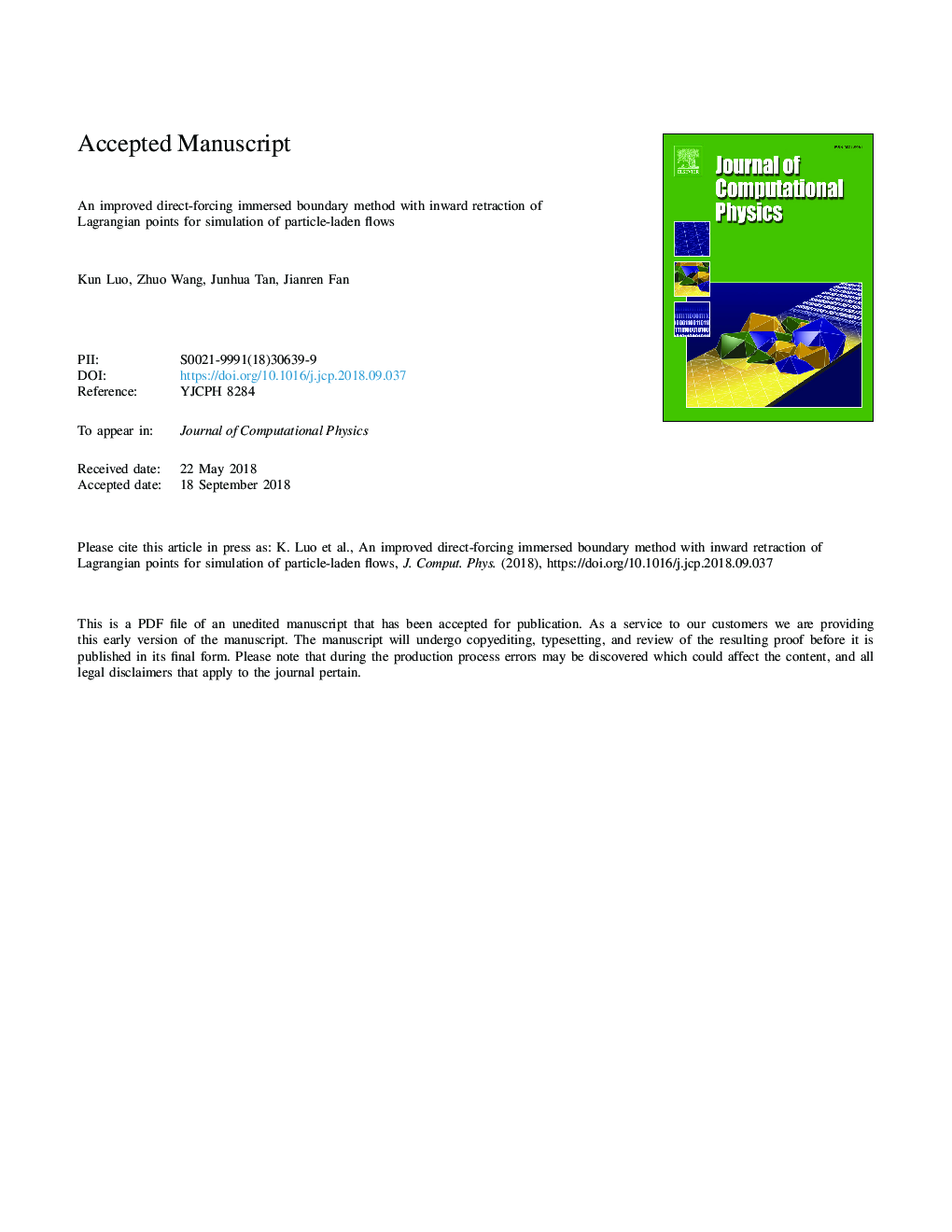| کد مقاله | کد نشریه | سال انتشار | مقاله انگلیسی | نسخه تمام متن |
|---|---|---|---|---|
| 11023888 | 1701236 | 2019 | 46 صفحه PDF | دانلود رایگان |
عنوان انگلیسی مقاله ISI
An improved direct-forcing immersed boundary method with inward retraction of Lagrangian points for simulation of particle-laden flows
ترجمه فارسی عنوان
یک روش مرزی تعبیه شده مستقیم مستقیم و مجزا با بازتاب داخلی نقاط لاگرانژ برای شبیه سازی جریانهای ذره ای
دانلود مقاله + سفارش ترجمه
دانلود مقاله ISI انگلیسی
رایگان برای ایرانیان
کلمات کلیدی
روش مرزی غوطه ور، مستقیم مجبور قطر هیدرودینامیکی موثر، عقب نشینی درونی، تصحیح پویا،
ترجمه چکیده
مرزهای غوطه ور مستقیم مستقیم به طور گسترده ای برای مطالعه جریان های ذره ای استفاده می شود. قطر مؤثر هیدرودینامیکی ذرات، با توجه به تعداد رینولدز ذره و رزولوشن شبکه، به واسطه روش مرزی غوطه وری اصلی، به مراتب بیش از حد قابل ملاحظه است. در این مقاله، یک روش بهبود یافته برای تعمیم دینامیکی قطر هیدرودینامیکی موثر با جابجایی نقاط لاگرانژ در داخل به فاصله های مختلف ارائه شده است. فاصله کشش با پرسیدن یک تابع مطابق در این مقاله تعیین می شود. روش بهبود یافته توسط چندین مورد آزمایش و تایید شده است، از جمله کاهش ذرات کروی تحت جاذبه، جریان یکنواخت دو ذره ثابت شده و پدیده آماده سازی، بوسیدن و افتادگی دو ذره استقرار. به نظر می رسد که روش بهبود یافته نه تنها نتایج بهتر را برای نیروی کششی فراهم می کند بلکه میدان جریان را نیز با دقت بیشتری پیش بینی می کند. به علاوه، به علت عدم حساسیت به رزولوشن شبکه، روش بهبود یافته برای شبیه سازی سیستم های ذرات مضاعف در مقیاس بزرگ مانند تخت مایع، که به صورت محاسباتی گران است، مناسب است.
موضوعات مرتبط
مهندسی و علوم پایه
مهندسی کامپیوتر
نرم افزارهای علوم کامپیوتر
چکیده انگلیسی
The direct-forcing immersed boundary is widely adopted to study particle-laden flows. The effective hydrodynamic diameter of the particle is much or less overestimated by the original immersed boundary method, depending on the particle Reynolds number and grid resolution. In this paper, we propose an improved method to dynamically correct the effective hydrodynamic diameter by retracting inward the Lagrangian points to varying distances. The retraction distance is determined by querying a function fitted in this paper. The improved method is tested and validated by several cases, including falling of a spherical particle under gravity, the uniform flow past two stationary particles and the drafting-kissing-tumbling phenomenon of two settling particles. It turns out the improved method not only provides better results for the drag force but also predicts the flow field more accurately. What's more, due to the insensitivity to grid resolution, the improved method is suitable for simulating large-scale fluid-particle systems such as fluidized bed, which are computationally expensive.
ناشر
Database: Elsevier - ScienceDirect (ساینس دایرکت)
Journal: Journal of Computational Physics - Volume 376, 1 January 2019, Pages 210-227
Journal: Journal of Computational Physics - Volume 376, 1 January 2019, Pages 210-227
نویسندگان
Kun Luo, Zhuo Wang, Junhua Tan, Jianren Fan,
